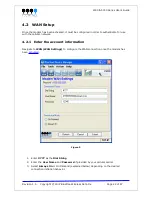
6.1.1 Port-forwarding
Since the 4000/5000 series modem is a network address translation (NAT) enabled router, the
remote computer connecting to the modem’s cellular WAN IP cannot access devices/servers on
the modem’s LAN if the modem is not specifically configured to forward the appropriate ports
to the LAN devices/servers. Port-forwarding, or tunneling, is the act of relaying an incoming
packet to one or more local destinations depending on the port(s) through which the packet
came.
The main use of port-forwarding is to allow an external user to reach a port on a private IP
address from the outside via a NAT. This allows remote computers to connect to a specific
computer within a private LAN, depending on the port used to connect.
To set up the modem's port forwarding rules, navigate to
CONF (Modem Configuration) >
Port Forwarding/DMZ
.
The WAN Port is the destination port number used by the remote computer and the LAN Port is
where the data is forwarded to. Typically the WAN port and LAN port are the same. Select the
appropriate protocol (TCP or UDP), and submit the new settings.
Figure 13






























